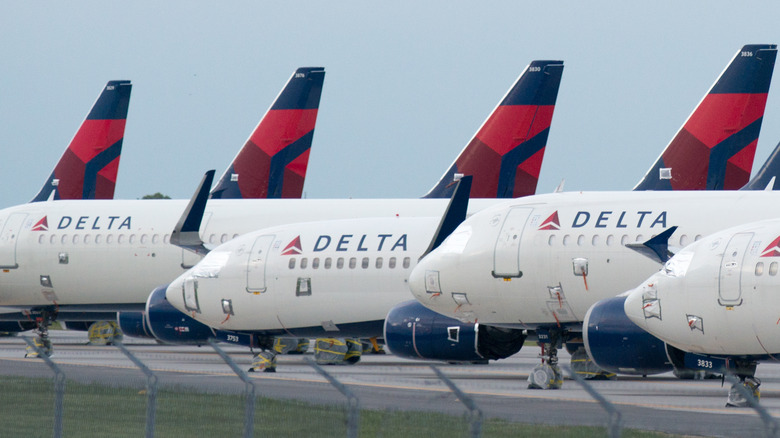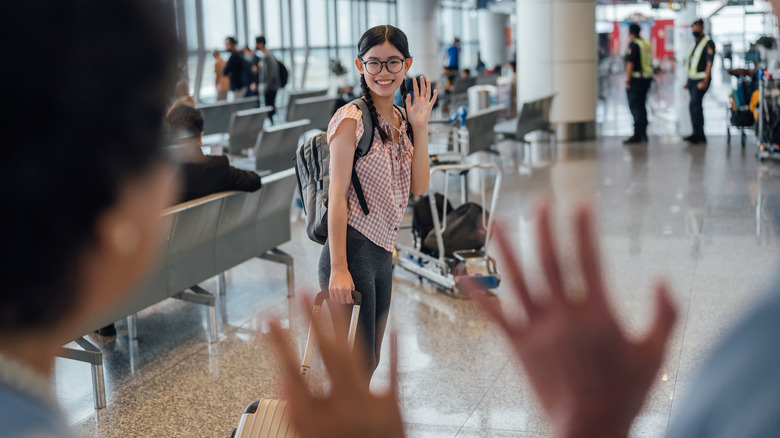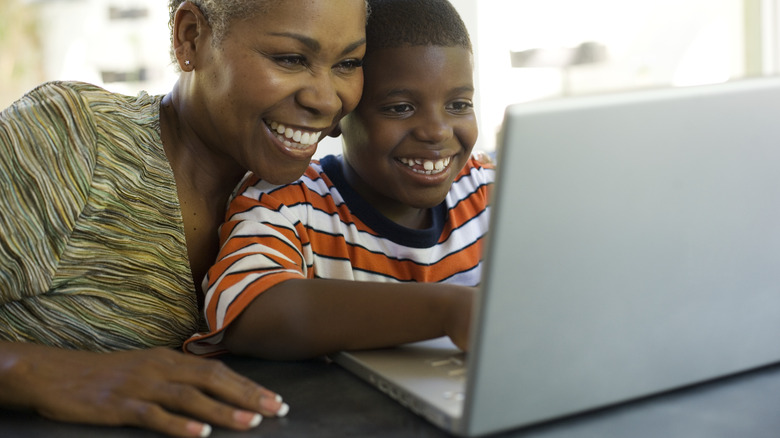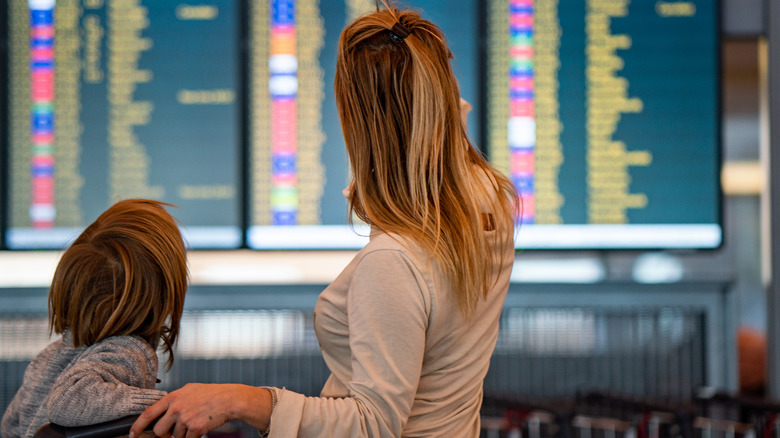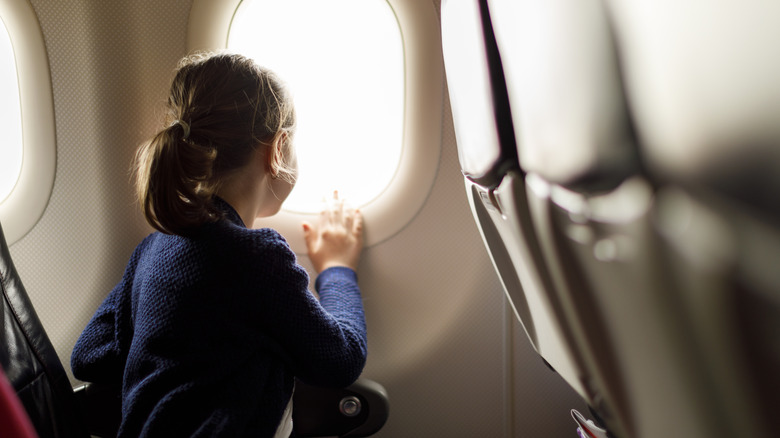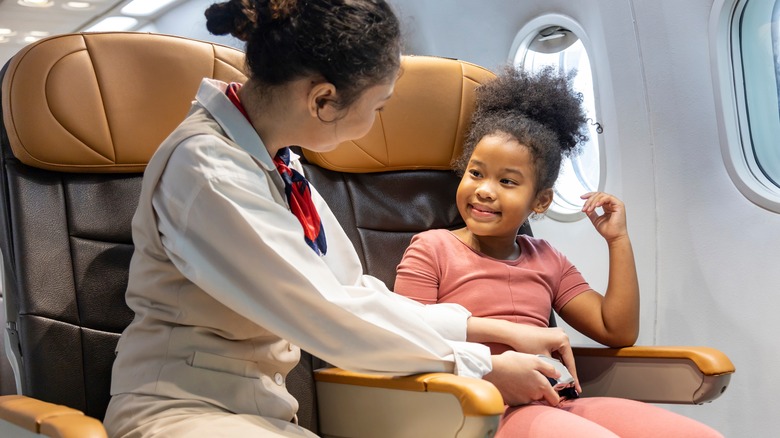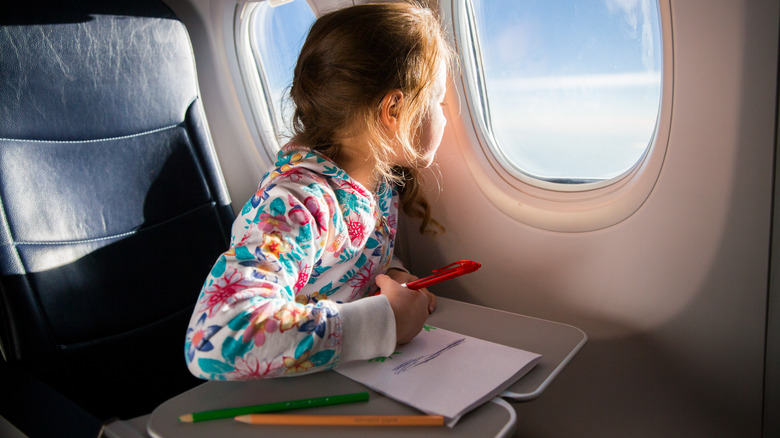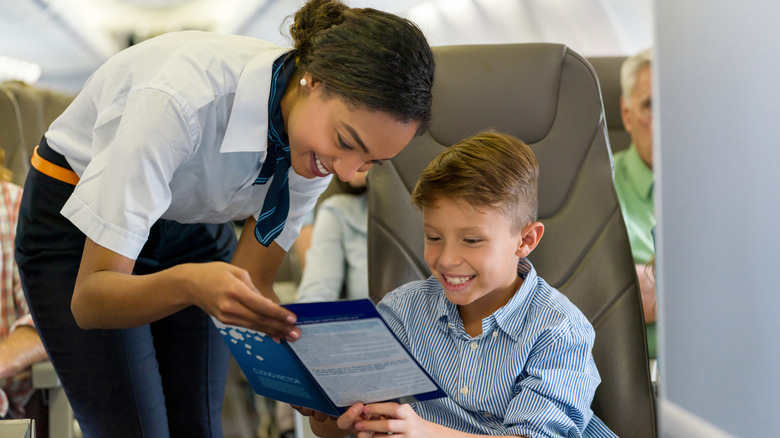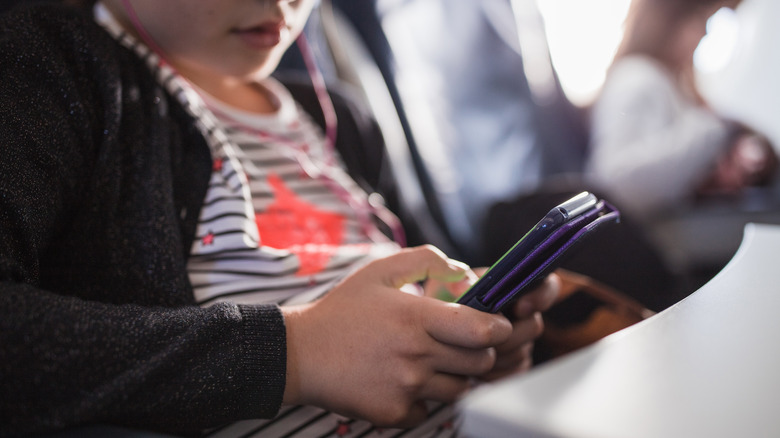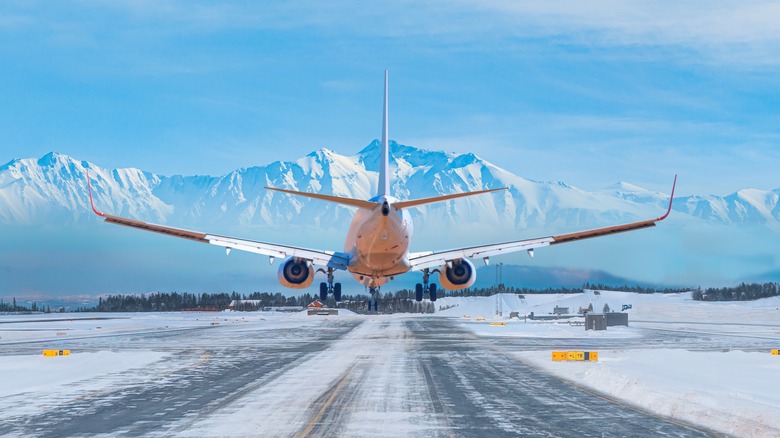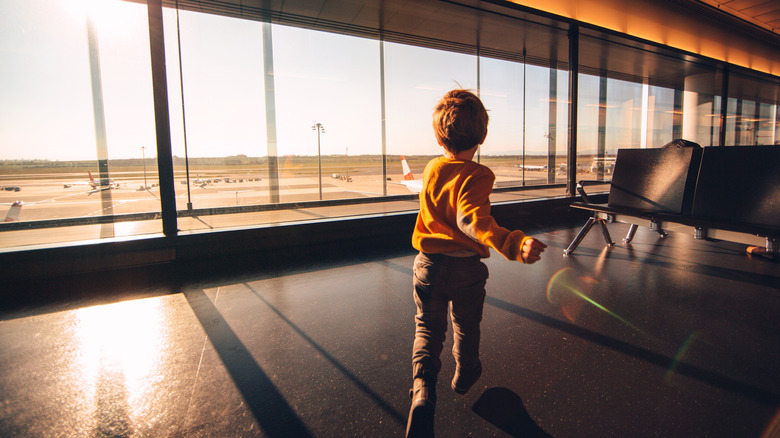Safety Tips For Flying As An Unaccompanied Minor
Traveling with kids can be stressful, but that's nothing compared to the bundle of nerves that forms in the stomach when they travel solo. There may come a time when a minor needs to travel via plane without an adult, whether it be due to a custody arrangement, wanting to visit faraway family, or any number of other reasons. It sounds like a nerve-racking experience, but most airline companies have an unaccompanied minor program to help those young passengers get where they need to be — meaning, your child isn't exactly left completely alone to get to their destination.
While different airlines may differ a bit in the age range, typically children aged 5 to anywhere from 11 to 14 years of age are considered an unaccompanied minor as long as they are not traveling with someone older than the cut-off age. Even with this program in place, it's only natural to be more than a little nervous about your little one getting on a plane and flying away from you solo, so feel free to take these safety tips to heart and implement them where you feel it necessary for you and your family.
Consider more than just your child's age
When it comes to rapidly growing humans, there really is no normal. All children are different and mature at vastly different rates. For example, some 13-year-olds may be responsible enough to care for other children solo and some may not, which makes it hard to create a blanket statement on what age is appropriate for a babysitter. It's the same idea for flying alone, as some 5-year-olds would be capable of staying calm and aware in an airport while catching a flight, while others could be quite traumatized by the experience of being on their own in such a new and intense environment.
You, as a parent or guardian, are more likely qualified to decide if your child would be comfortable and capable of flying on their own. Don't use the airline's cut-off age for unaccompanied minors to decide if your child is emotionally mature enough to fly on their own. It's in everyone's best interest that you use your own judgment in regards to whether or not your child is up to the task — the child in question will be more comfortable if they can confidently board the plane, as well as the airline staff, other passengers, and even you yourself.
Be selective of your airline
If you have a choice in the matter, research various airlines that have an unaccompanied minor program and compare them, as you may end up feeling that some programs are more helpful and extensive than others. Fees differ from airline to airline with $150 being the maximum, one-way cost of utilizing the unaccompanied minor program, but you may find value in spending this maxed-out price to make sure your child is more comfortable traveling alone.
If your child flies Delta, for example, the $150 fee includes a trackable wristband and access to the kids' Sky Zone lounge, which is a fun space for children to feel comfortable and entertained while waiting out connections or layovers. American Airlines also includes kids' lounges and an activity pack with snacks in some cities, making the $150 fee a little more worth it.
Some airlines' unaccompanied minor programs may not even be an option for your specific situation. For example, Southwest Airlines doesn't consider anyone over the age of 11 an unaccompanied minor, which means if you have a 12-year-old who needs to fly alone, they will not be receiving the help of the airline to do so. If you feel as though your child needs the program at this age, finding a different airline to book with would be necessary.
Understand the process
We've already established that not all airlines are created equal, which means that each airline has its own policies and guidelines, and that also applies to its unaccompanied minor program. Be sure to read through all of the information on the program provided by your airline, including any emails you may have received after booking. This will help you understand where your child needs to be and when they need to be there, along with how long you will be able to help them along the way.
Know the rules regarding whether or not you can accompany your child to the gate. While the majority of airlines that offer the unaccompanied minor program encourage or even require a guardian to be present at the gate, Jet Blue is one airline that leaves the issuance of a gate pass to the discretion of the TSA and does not guarantee that the non-flying adult will be able to see the child to the gate. If seeing your child to the gate is important to you, make sure to book with an airline that guarantees a gate pass.
It's important to understand exactly what will be expected of your child and how things will go transpire the day of the flight, for more reasons than just getting your child to their destination. Providing a calm and knowledgeable front to your child will help them feel confident and ready to tackle a solo flight.
Take a digital tour
If your child has never flown before, traveling all on their own will be extra daunting. Airports and planes are kind of otherworldly and while some people enjoy the energy they put off, it can be jarring to first-timers. You can help alleviate some stress by preparing kids for what the plane and airport will look like. If they know what they are walking into, the bizarre atmosphere of an airport and a seemingly gravity-defying aircraft won't be quite as overwhelming when they are actually experiencing it.
Plenty of airlines have digital tours of their planes available, and finding them is as simple as doing a search of your airline on YouTube. Exploring the different areas of the plane digitally and getting a visual of what their surroundings will look like could help your child feel more at ease once they are physically on the plane. This will keep them focused on getting through any big feelings they may have about takeoff and their time spent in the air.
Luckily, you can prepare for much more than just the plane in this way, as there are also digital airport tours available online for various airports. Sitting down with your child and going through the different areas of the airports they'll depart from and arrive to will help prepare them for what some would consider to be the most stressful part of flying: navigating the labyrinth of terminals and checkpoints that make up an airport.
Practice and recite the itinerary
Don't throw your kid into high altitudes without thoroughly preparing them for what is about to happen, especially if they have never been to an airport or on a plane before. Create an itinerary of what will need to happen once you arrive at the airport. You should have read your chosen airline's detailed unaccompanied minor information on their website and anything they may have sent you after booking your child's flight. Based on this, lay out what will happen and go through it a few times with your child.
While you should run through your itinerary one more time on the day of the flight, don't wait until right before the flight to explain the process. Repetition is key for retention, as the brain holds on to information better when learned multiple times. Your child will have a better time remembering what they need to do if you walk them through it a few times before the big day, and they'll be able to feel confident in their travels if they know what is expected of them.
Simplify the itinerary
While it's important to explain what your child will need to do once they get to the airport and during their journey to their destination, you don't want to make it too complicated. The more simple your instructions are, the more likely your child is to be able to remember everything. Writing out a very basic list and leaving the detailed explanation for your verbal practices may be the best way to approach things. Since you will likely be with your child up to the gate, you can help them start to mark off items on the list as you complete them.
Also, keeping the flight a simple one by booking a direct flight with no connections will help eliminate many complications that can arise with travel. Some airlines, like Southwest Airlines, will not allow unaccompanied minors to book flights that switch planes on connections for this reason. Depending on your circumstances, a direct flight may not be possible — however, the more straightforward the plan and flight are, the easier it will be for your child to get where they need to be without any hitches.
Be strategic when choosing a seat
A lot of airlines recommend booking a seat at the back of the plane, but you may want to consider booking at the front of the plane as well. Depending on your airline, the flight attendants will either be located in the back or front of the plane and it's wise to align your child's seat to where they will be in the line of sight of an attendant as often as possible. This is where those digital tours will come in handy, as you can get an idea of where you should book your child's seat.
Sometimes you may not have a choice, as airlines like United Airlines choose your child's seat themselves. If it is important to you that you get to choose where your child will be on the airplane, you will need to book through an airline that has that capability. Alternatively, if you'd rather the airline choose what they deem best for an unaccompanied minor, sticking with United Airlines or a similar company may be best — they are the ones who will be keeping an eye on your child while on the plane, after all.
Pack for the plane
It's a good idea to pack for the unaccompanied trip in addition to everything they will need on their trip. Flight-approved snacks as well as something to occupy them during the flight can help your child stay calm and relaxed. A lot of airlines do recommend that you pack a game or two, as well as have all electronics fully charged. While this isn't a major safety issue, keeping your child occupied could prevent some distress.
Some airlines will provide your child a snack included in your unaccompanied minor fee, but even if they do it may be a good idea to pack some snacks that you know your child enjoys. Since flying, especially alone, can be pretty stressful, having something familiar could be a comfort. If you typically are strict about sugary snacks or healthy foods, you may deem the flight to be a special occasion and lift some restrictions to better help keep your child excited about their time on the plane.
Snacks and a couple of activities don't have to take up a ton of room, and you should be able to find some space in the carry-on bag for them. Don't forget to suggest whoever will be taking your child to the airport for their return journey to pack some snacks as well!
Keep important information and documents together
A lot of airlines will give your child a lanyard to wear at all times, as this helps distinguish them from other passengers and to help flight attendants and airline staff keep track of them. You can add important contact information here so that there is little chance your child will lose it. Any other important documents that your child needs should be either kept here with the contact information, or you can put together a folder for their carry-on and explain that they need to keep it in their bag at all times.
The airline should already have your phone number on file, as well as the information of the adult set to meet your child at the arrival gate, in case any emergencies or flight delays take place. However, it's still important that you provide your child with all of the information as well. This way, your child is able to get in touch with you themselves or they are able to give your information to another responsible adult in case of emergencies — chances are they will never need to do this, but preparing for disaster is a way to avoid one.
Leave your child with a communication device
Although voice phone calls are typically prohibited while an airplane is in the air, your child can use the plane's Wi-Fi to send text messages. In addition to having your contact information written down, they should have your number programmed into their device to easily reach you and the other adults in their life. They may find comfort in being able to contact you with any concerns while in the air.
Older children may be very familiar with the workings of a phone or tablet, but if your younger child isn't, you should educate them on how to at least make calls. They should know how to reach you on their own if they are traveling solo, even though they shouldn't need to.
Being able to communicate with you and the person they are traveling to could prove valuable as well, especially if they don't see who they are supposed to meet when they get off the plane. You and their arrival adult need to be available during and after the flight for your child or airline to contact you, because they will if there are any unforeseen changes. Make sure you know when your child arrives as scheduled, because only then can you stop listening for an important call.
Check the weather
Most unaccompanied minor programs are thankfully pretty straightforward, but that's if everything falls into place perfectly. As most jetsetters know, air travel can be unpredictable and delays are an unfortunate common occurrence. When your child is traveling solo, one of the last things you want to happen is an unexpected delay, especially if it lasts for a significant amount of time.
Checking the weather forecast for any kind of pattern that may pose a risk could help avoid an unwanted situation where your child is left waiting extended times in an airport alone. Unless you really can't help it, don't book your child to fly when there are winter or storm advisories. Rebooking may also be an option if you check the weather closer to the flight date and don't like what you see.
Every once in a while, an unaccompanied minor is stuck in travel limbo overnight. In this case, the airline is supposed to continue watching over them and provide them with a safe place to stay, whether a hotel room or somewhere in the airport itself. However, you will want to do everything in your power to avoid this — unfortunately, mechanical failures are pretty much impossible to foresee when booking.
Keep to the gate
A good general safety rule is to set up checkpoints with your family so that if you ever get separated, you know you can meet up with each other in specific locations. When air travel is involved, a good rule of thumb is to make the gate that checkpoint, so no one leaves the gate until everyone is together or knows the travel plan is on track.
Hopefully, your airline allows you to get your child to the gate and if they do, it's important to wait there until your child's plane is off the ground. Some airlines require you to be at the gate until liftoff, and some even for a set amount of time after. It's important for whoever is picking your child up to be at the arrival gate as well. Just in case the adult who is picking your child up is delayed or can't make the arrival gate before your child gets there, make sure your child knows to wait at the gate until they see the person they are supposed to go with.
The gate should absolutely be the meet-up place when a child is traveling solo, so that no one has any confusion and your child isn't wandering a new airport by themselves. The airline staff will help prevent this situation from arising, but it's best to do all you can to establish that everyone needs to stick to the gate.


